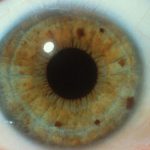 A pseudoscience that is based on the belief that most abnormalities of the body cause abnormal markings in the eye.
A pseudoscience that is based on the belief that most abnormalities of the body cause abnormal markings in the eye.
The analysis of patterns and structures in the iris of the eye to assess person’s general health and to detect certain forms of disease. The belief is that the iris is divided into six regions by which an iridologist can study the shape and color of the iris and correlate it to disease processes. Iridology is considered by those who practice it to be a safe, noninvasive, inexpensive diagnostic tool, one that can ascertain whether a person has a good constitution, whether he or she has nutritional imbalances, and whether toxic substances are present in the body. Iridology does not identify specific diseases but provides general information about body tissues. However, scientific investigations have failed to show any clinical effectiveness for iridology.
A diagnostic method developed by Dr. Ignatz von Peczely, a 19th-century physician, and used today by some alternative medicine practitioners, in which disease is indicated by the variations in the color, morphology, or other characteristics of the iris. It has not been shown to have reliable reproducibility or proven scientific validity.
A method of diagnosing illnesses from the appearance of, and changes in, the iris of the eye. It is a diagnostic technique and not a treatment. A sectional map is made of the iris with precise positions located that refer to parts or functions of the body or head. If a spot or color change is found in a certain position on the iris, the practitioner will be able to locate the exact seat of the ill¬ ness. The system was invented by Ignatz Peczely, a Budapest doctor, who published a book in 1880 that at the time inspired homeopaths practicing in Germany and Sweden. The practice of iridology was introduced into the United States by Henry E. Lahn, who in 1904 wrote the first book published in English on the subject. Later, in 1917, a pupil of Lahn’s, Henry Lindlahr, produced a definitive study of naturopathic diagnosis called Iridiagnosis and other Diagnostic Methods.
Lindlahr wrote that Peczely made this great scientific discovery when, at the age of 10, he caught an owl and accidentally broke its foot. At the precise moment that the bone snapped, he was looking into the bird’s eyes and noticed the sudden appearance of a black spot in the lower central region of its iris. Taking the bird home for a pet, the boy found that as the leg healed the black spot developed a white border, which was, according to Ignatz, related to the formation of the scar tissue around the bone.
